
When the director John Henry Richardson, former senior instructor of the New York Film Academy acting department, and his producing partner, Mark Mockett, former supervising editor at the film academy, learned that their former international students were becoming discouraged with their acting careers, Richardson decided to embark on a journey to interview them about their lives since graduating film school. Encompassing seven countries and 30 interviews, Richardson learned that one of his students disappeared under mysterious circumstances, and still hasn’t been found. This was the springboard that became the inspiration for Richardson and Mockett, who have worked on nearly 500 student and thesis films together, to make the docu-mystery Where Is She Now?
Because the story was not originally intended to be a feature film, footage required a lot of fixing in post. Challenges with proper lighting and types of cameras used during production required AlphaDogs colorist Terence Curren to come up creative ways to make the film look its best. Curren chose to finish the film in Avid Symphony to reduce the complexities of round-tripping to third-party applications with various mixed media formats. To fix footage that was shot in uncontrolled lighting environments, Curren used Avid’s Spot Color effect to isolate sections of the images to be adjusted independent of the rest.
“While this process of color correction is easier in some other products, there’s a trade-off with the complexities in moving between applications,” Curren noted. “In this case staying in one application was the better workflow.”
All this work paid of in the finished product. “All the natural lighting caused many changes in color temperature and light levels,” said Mockett. “Terence made it look like we had an army of gaffers on location lighting the scenes for us wherever we were. The man is a miracle worker.”
AlphaDogs audio engineer Curtis Fritsch used CEDAR and Izotope RX plugins to clean up harsh background noises, ensuring that the dialogue could be heard in a clear manner. “Curtis worked wonders on the sound with a scene we filmed on a boat,” said Mockett. “With the problematic water noise, I was certain ADR would be needed, but Curtis found the dialogue and made it sound fantastic.”
Richardson and Mockett hope that audiences will gain some insight into how difficult the world of acting really is, and how hard it is to make a living. Richardson commented, “There is strength in friendship, and that strength can move mountains.”
Richardson and Mockett’s film has been invited into competition at the WMIFF (World Music & Independent Film Festival), where it is nominated for three awards: best documentary film, best director and best actor. “AlphaDogs has enabled us to become a viable film fest contender in a field of films that were made for much higher budgets,” Richardson said.





